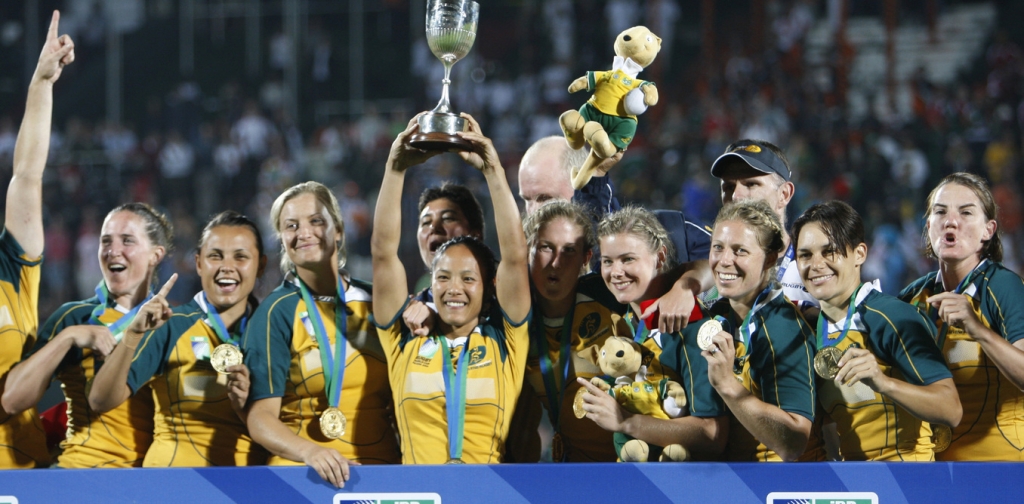Rugby Sevens is a relatively young sport. Although it has been played since the late 19th century, the World Rugby Sevens series, which consists of 12 international tournaments, originated in 1999. It wasn’t until 2009 that the popularity of Sevens boomed through its inclusion in the Olympic program.
The sport is played with seven athletes on each side for two halves of seven minutes. This means athletes in the sport combine lightning speed, incredible strength and exceptional skilfulness, as well as tactical ability, to outpace, outmuscle and outsmart their opposition.
Perils of youth
The recent increase in the popularity of the sport means there has been limited opportunity for the long-term development of players.
To put this into perspective, athletes in more traditional Olympic disciplines, such as athletics or gymnastics, spend ten or more years in rigorous training programs before reaching the elite level.
This extensive process of talent development often results in very few reaching expert performance levels, but it might not even be necessary for achieving Olympic success.
Indeed, why years of specialised training may not be the best approach can be explained using the example of rugby Sevens.
Because the game has only recently experienced a popularity boom and relatively few athletes worldwide are frequently competing in the sport, countries have adopted a different approach to identifying the best athletes to compete in the rugby Sevens in the Rio Games.
This strategy is called a “talent transfer”: a process that identifies athletes from different sports who have the qualities to help them perform well in rugby Sevens.
A great example of how effective talent transfer can be is the Australian women’s Sevens team. The team is ranked first in the HSBC Sevens series and consists of women with diverse sporting backgrounds – in touch rugby, rugby league, rugby union, basketball and track and field.
Indeed, Australia has won the first-ever Olympic gold medal to be awarded for women’s rugby Sevens in a decisive 24-17 victory.
A good example
Australia successfully applied talent transfer to skeleton bobsledding at the 2006 Torino Winter Olympic Games. Skeleton bobsleigh is traditional bobsleigh’s more dangerous nephew; it requires athletes to push a one-man sleigh from an ice track and then steer the sleigh face-first over a winding course.
In 2008, Australia selected four athletes from a variety of sports based on their sprinting ability – an important performance predictor for skeleton bobsledding – and their skeleton-specific potential.
The four athletes who remained after the selection process underwent a rigorous, short-term training program. The ones who made it to the end represented Australia at the 2006 Winter Olympics. The team came 13th – after only 14 months of training.
But how can talent transfer be applied to rugby Sevens, an arguably far more dynamic and multi-factorial sport than skeleton bobsledding? Although the talent transfer process differs between sports, the strategy always uses the same general progression.
First, the sport of interest – in this case rugby Sevens – is broken down into several performance-related components. For example, highly successful rugby Sevens players are either fast, fit, skilful, strong or all of the above.
Then, the performance-related factors are ranked by their ability to be cultivated over short periods of time. For example, increasing strength and power to adequate levels of performance through structured training is relatively easy for elite athletes, and fitness is a given.
Both speed and skilfulness are less prone to changes due to training. So those qualities are fundamental to the talent transfer strategies used by many of the nations competing in Rio 2016.
Planning for gold
In the lead-up to the Olympics, nations with an eye on competing started recruiting skilful and fast players into their teams, often from other compatible sports such as netball, soccer and track and field.
All of these sports require attributes that are compatible with modern rugby Sevens. However, rather than develop them from scratch, the Australian Rugby Union transferred people with these attributes from other sports, then cultivated rugby Sevens-related skills.
The method is clever as it delivers much faster results than developing rugby Sevens players from a young age.
Rugby Sevens serves as the perfect example of how lifelong dedication to a single sport might not be the only pathway to Olympic success. A well-developed skill set and exceptional athletic qualities might possibly give athletes a chance to transfer their talents to other, lesser-known sports, with the hope of securing Olympic gold.
 Job Fransen does not work for, consult, own shares in or receive funding from any company or organisation that would benefit from this article, and has disclosed no relevant affiliations beyond the academic appointment above.
Job Fransen does not work for, consult, own shares in or receive funding from any company or organisation that would benefit from this article, and has disclosed no relevant affiliations beyond the academic appointment above.
Job Fransen, Lecturer in Skill Acquisition and Motor Control, University of Technology Sydney
This article was originally published on The Conversation. Read the original article.




 PUMA and Porsche Collaborate on the Crews Go Summer Collection
PUMA and Porsche Collaborate on the Crews Go Summer Collection  PUMA and Breanna Stewart Launch Stewie 3 in Paris
PUMA and Breanna Stewart Launch Stewie 3 in Paris  Adidas Spezial Collection 2024: A Sneak Peek Into the Latest Drop
Adidas Spezial Collection 2024: A Sneak Peek Into the Latest Drop  Adidas Unveils Innovative Team Kits for Paris 2024 Olympics and Paralympics
Adidas Unveils Innovative Team Kits for Paris 2024 Olympics and Paralympics  PUMA and Mercedes-AMG PETRONAS F1 Team Launch Crews Go Summer Collection
PUMA and Mercedes-AMG PETRONAS F1 Team Launch Crews Go Summer Collection  Striking Colorways Set To Ignite the Pitch This Summer With Puma’s FOREVER. FASTER. Football Boot Pack
Striking Colorways Set To Ignite the Pitch This Summer With Puma’s FOREVER. FASTER. Football Boot Pack  Adidas Originals and BAPE Unleash the Adidas N BAPE Sneaker This April
Adidas Originals and BAPE Unleash the Adidas N BAPE Sneaker This April  PUMA Launches "FOREVER. FASTER. - Global Campaign
PUMA Launches "FOREVER. FASTER. - Global Campaign  The Art of Climbing: a brief history of photographing rock-climbing
The Art of Climbing: a brief history of photographing rock-climbing  Kawhi Leonard and New Balance Launch the Highly Anticipated KAWHI IV Sneaker
Kawhi Leonard and New Balance Launch the Highly Anticipated KAWHI IV Sneaker  The Nike Luka 3, Unveiled with Advanced Technology and Sustainability
The Nike Luka 3, Unveiled with Advanced Technology and Sustainability  PUMA x KidSuper Collaboration Unveils New Sports Club Collection
PUMA x KidSuper Collaboration Unveils New Sports Club Collection  Adidas Originals and Edison Chen Unveil the Black CLOT Superstar in Latest Fashion Forward Collaboration
Adidas Originals and Edison Chen Unveil the Black CLOT Superstar in Latest Fashion Forward Collaboration  Coca-Cola Amplifies 'Celebrate Everyday Greatness' Theme for the 2024 Paris Olympics
Coca-Cola Amplifies 'Celebrate Everyday Greatness' Theme for the 2024 Paris Olympics  Nike SB Unveils Day One for Next-Generation Skaters
Nike SB Unveils Day One for Next-Generation Skaters  London Marathon: how visually impaired people run
London Marathon: how visually impaired people run 































